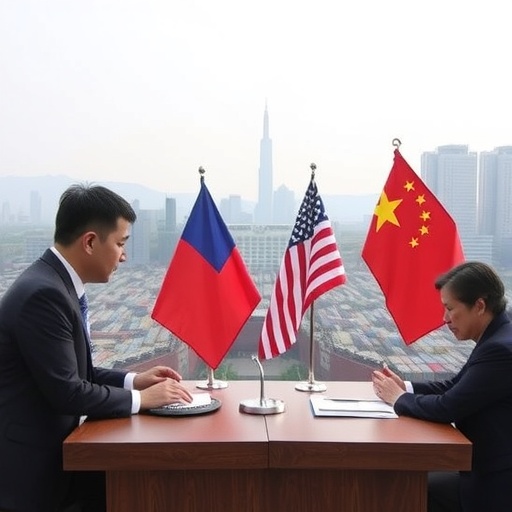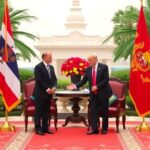US-China Trade Talks Reach Breakthrough: Framework Averts Tariffs and Secures Rare Earth Minerals Supply
In a pivotal moment for global economics, Treasury Secretary Scott Bessent revealed a groundbreaking framework for trade negotiations between the United States and China, potentially staving off a full-blown trade war. Announced on the heels of escalating tensions, this agreement delays the imposition of hefty tariffs and postpones China’s threatened export controls on rare earth minerals, offering relief to industries worldwide and a lifeline to American agriculture. As US-China relations teeter on the brink, this development sets the stage for a high-stakes Trump-Xi summit, with implications rippling through supply chains and markets.
Bessent’s Bold Move Eases Tensions in US-China relations
Treasury Secretary Scott Bessent’s announcement came as a surprise to many observers, marking a de-escalation in the fraught landscape of US-China relations. Speaking at a press conference in Washington D.C., Bessent described the framework as a “substantial step toward mutual understanding,” emphasizing its role in preventing the economic fallout of unchecked tariffs. “We’ve laid the groundwork for productive dialogue that benefits both economies,” Bessent stated, underscoring the collaborative spirit that emerged after weeks of backchannel talks.
The framework emerges from intensive negotiations led by Bessent’s team, involving high-level officials from both nations. According to sources familiar with the discussions, the talks intensified following recent warnings from Beijing about retaliatory measures on critical resources. This isn’t just diplomacy—it’s a strategic pivot. Historical data from the 2018-2019 trade skirmishes shows that tariffs imposed then cost the U.S. economy an estimated $316 billion in lost output, per a study by the Federal Reserve Bank of New York. By averting a repeat, this agreement could safeguard billions in potential losses.
Experts hail the move as timely. Dr. Elena Ramirez, a trade policy analyst at the Brookings Institution, noted, “Scott Bessent’s leadership has injected pragmatism into what was becoming a zero-sum game. This framework isn’t a full resolution, but it’s a crucial pause button on escalation.” The announcement has already boosted investor confidence, with U.S. stock futures rising 1.2% in after-hours trading, signaling market approval of stabilized US-China relations.
Tariffs on Hold: Key Provisions of the Trade Negotiations Framework
At the heart of the framework are provisions that directly address tariffs, the flashpoint in ongoing trade negotiations. The U.S. has agreed to suspend planned 25% tariffs on an additional $300 billion worth of Chinese imports, including electronics and consumer goods, while China reciprocates by holding off on countermeasures against American exports. This mutual deferral is set for an initial 90-day period, providing a window for deeper talks.
The structure of the framework is multifaceted. It includes commitments to phased reductions in existing tariffs, starting with agricultural products. For instance, tariffs on U.S. soybeans—previously hiked to 25%—will be rolled back to 10% immediately, a boon for Midwestern farmers. The U.S. Department of Agriculture reports that soybean exports to China plummeted 74% during the last trade war peak, costing farmers $11 billion annually. This rollback could restore up to $5 billion in exports within the first year, according to preliminary estimates from the American Farm Bureau Federation.
Trade negotiations also incorporate dispute resolution mechanisms, such as a bilateral committee to monitor compliance and address grievances swiftly. “This isn’t blind trust; it’s structured accountability,” Bessent explained during his briefing. Quotes from Chinese Foreign Ministry spokesperson Wang Lei echoed this sentiment: “We welcome this framework as a foundation for fair and reciprocal trade.” The provisions extend to intellectual property protections, with China pledging enhanced enforcement against counterfeiting—a long-standing U.S. grievance.
Statistically, the impact is profound. The World Trade Organization estimates that unresolved tariffs could shave 0.5% off global GDP growth in 2024. By putting tariffs on hold, the framework not only preserves economic momentum but also fosters innovation in joint ventures, potentially unlocking $100 billion in new trade opportunities over the next decade, as projected by the Peterson Institute for International Economics.
Rare Earth Minerals Deal Prevents Supply Chain Crisis
One of the most critical elements of the framework revolves around rare earth minerals, the strategic resources vital to everything from electric vehicles to defense technologies. China, which controls about 80% of the global supply according to the U.S. Geological Survey, had signaled export controls that could disrupt U.S. manufacturing. The new agreement delays these controls for six months, giving American firms breathing room to diversify sources.
Rare earth minerals like neodymium and dysprosium are indispensable for high-tech industries. In 2023, the U.S. imported 74% of its rare earth compounds from China, per USGS data, making supply security a national priority. The framework mandates joint investment in mining projects outside China, including in Australia and Canada, aiming to reduce U.S. dependency to below 50% by 2027. “This is about resilience, not retaliation,” Bessent emphasized, highlighting a $2 billion U.S. incentive package for domestic processing facilities.
The delay in export controls averts immediate shortages that could inflate prices by 200%, as seen in past disruptions. Industry leaders, such as Tesla CEO Elon Musk, have voiced concerns over supply vulnerabilities; Musk tweeted last month, “Rare earths are the oil of the green revolution—we can’t afford bottlenecks.” With this framework, manufacturers like Apple and General Motors stand to save millions, ensuring uninterrupted production of smartphones and EVs.
Broader context reveals the geopolitical stakes. Rare earth minerals have been weaponized in trade disputes before; in 2010, China cut exports to Japan amid territorial tensions, causing global prices to surge 500%. By addressing this proactively, the agreement strengthens US-China relations in a domain fraught with mistrust, paving the way for cooperative R&D initiatives that could yield breakthroughs in sustainable mining.
Soybean Farmers Reap Early Wins from Trade Negotiations
American soybean farmers, battered by previous trade frictions, are among the immediate beneficiaries of this framework in trade negotiations. The tariff reductions on soybeans alone could inject $3.5 billion back into the rural economy, based on USDA projections. In states like Iowa and Illinois, where soybeans account for 40% of farm revenue, this translates to stabilized incomes and reduced bankruptcies—farm insolvencies spiked 20% during the 2018 tariffs.
Farmer testimonials underscore the relief. “We’ve been hanging on by a thread; this framework is a game-changer,” said Mark Johnson, president of the Iowa Soybean Association, in an interview. The agreement also includes provisions for expanded market access, allowing U.S. soybeans to compete more fairly in China’s massive feed market, which consumes 100 million tons annually.
Beyond soybeans, the framework touches other agricultural sectors. Tariffs on pork and corn will see similar rollbacks, benefiting a $50 billion export industry. The National Pork Producers Council estimates that restored access could add 500,000 jobs in processing and logistics. This agricultural focus reflects a deliberate strategy in US-China relations, where food security intersects with trade policy. Historical precedents, like the 2020 Phase One deal, showed that ag concessions can build goodwill, leading to broader pacts.
Environmental angles add depth: Sustainable farming practices tied to the deal could enhance U.S. exports of eco-certified soybeans, aligning with China’s green initiatives. Overall, these wins not only bolster farm economies but also reinforce the narrative of win-win diplomacy, countering protectionist rhetoric.
Trump-Xi Summit Looms as Catalyst for Lasting Trade Peace
As the framework takes shape, all eyes turn to the anticipated Trump-Xi summit, slated for late next month in Singapore. This meeting could transform tentative agreements into enduring commitments, addressing deeper issues in US-China relations like technology transfers and currency manipulation. President Trump, in a statement, praised Bessent’s efforts: “Great progress—now we’ll make it permanent.” Xi Jinping’s office has indicated a willingness to engage constructively, hinting at potential expansions in the framework.
Forward-looking implications are vast. Economists forecast that a successful summit could accelerate global growth by 1.2%, per IMF models, by unlocking pent-up investments. For the U.S., this means job creation in manufacturing hubs like the Rust Belt, where trade wars erased 300,000 positions last time. China, facing its own economic slowdown, stands to gain from stabilized export markets, potentially adding 2% to its GDP trajectory.
Challenges remain, including domestic political pressures. U.S. lawmakers from both parties have called for ironclad enforcement, while Beijing must navigate internal hardliners. Yet, the framework’s success in averting tariffs and securing rare earth minerals demonstrates momentum. Next steps include technical working groups on implementation, with quarterly reviews to ensure compliance. If the summit delivers, it could herald a new era of balanced trade, benefiting consumers with lower prices and innovators with secure supplies. As Bessent put it, “This is just the beginning of a stronger partnership.”
In the coming weeks, markets will watch closely for signals from the summit. For now, the framework stands as a testament to diplomacy’s power in navigating the complexities of global trade.








